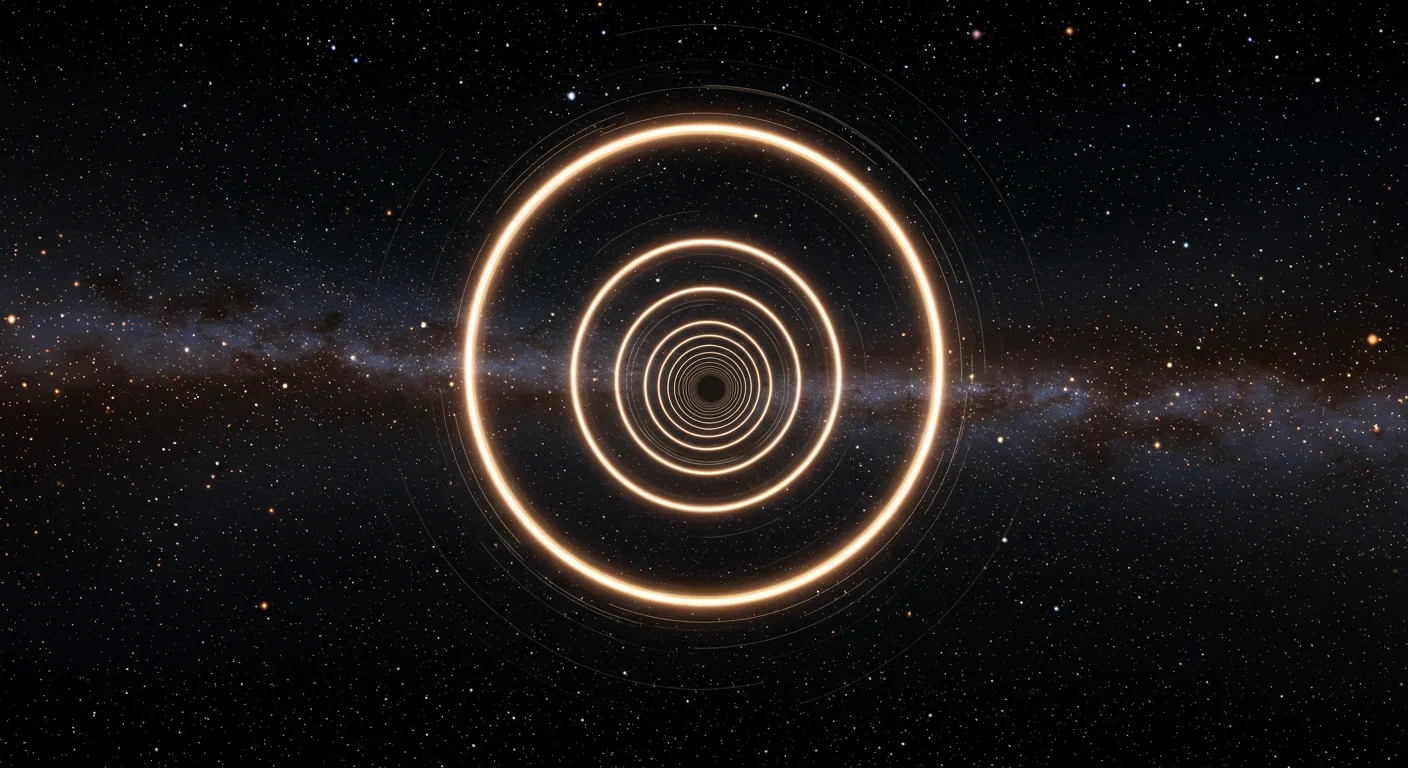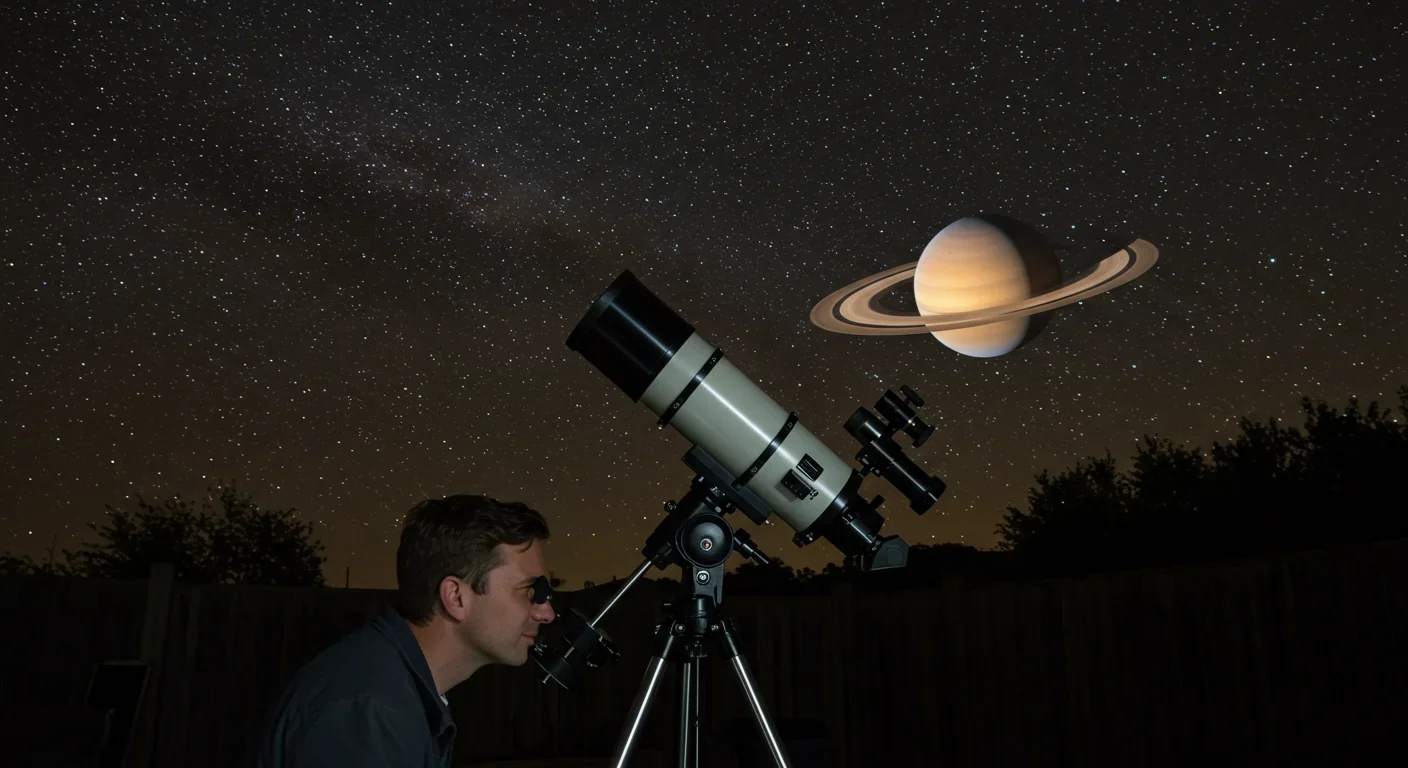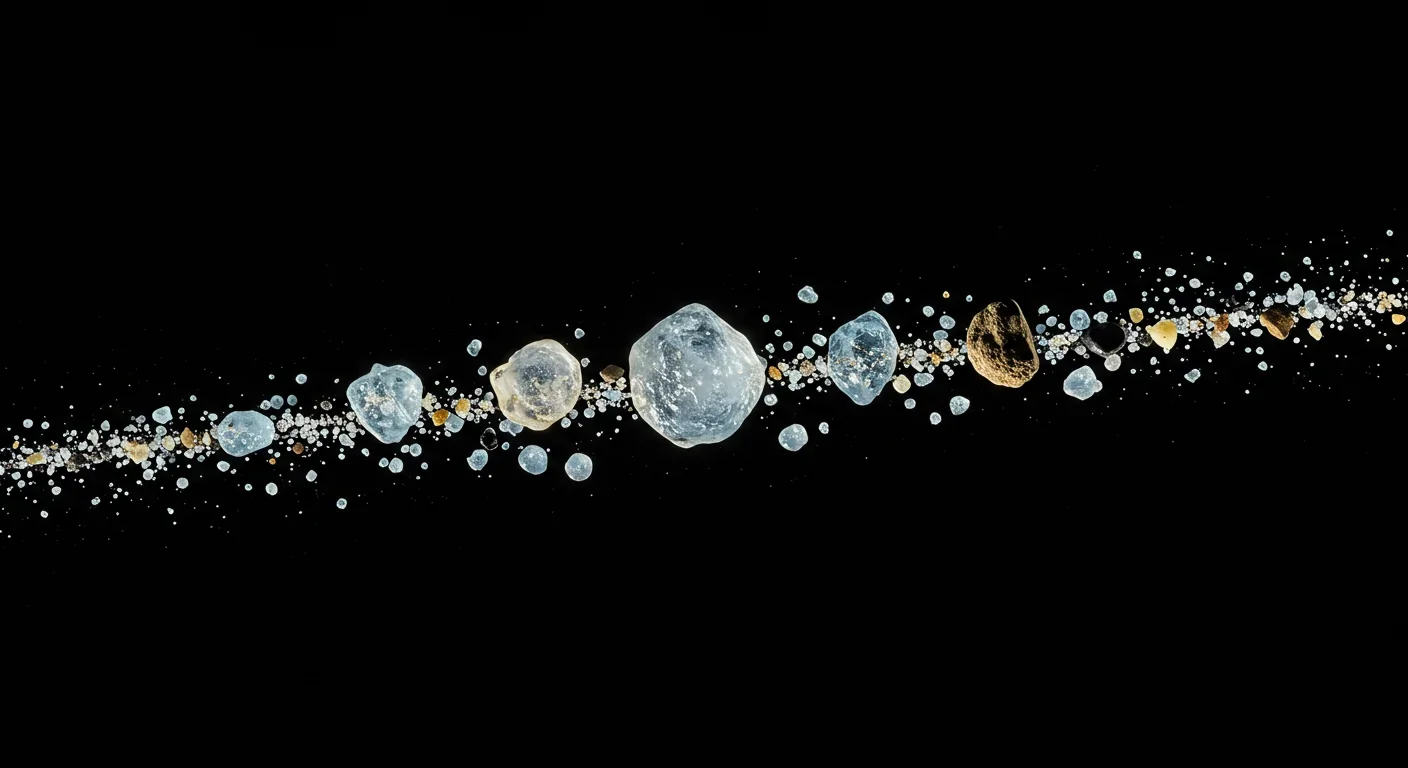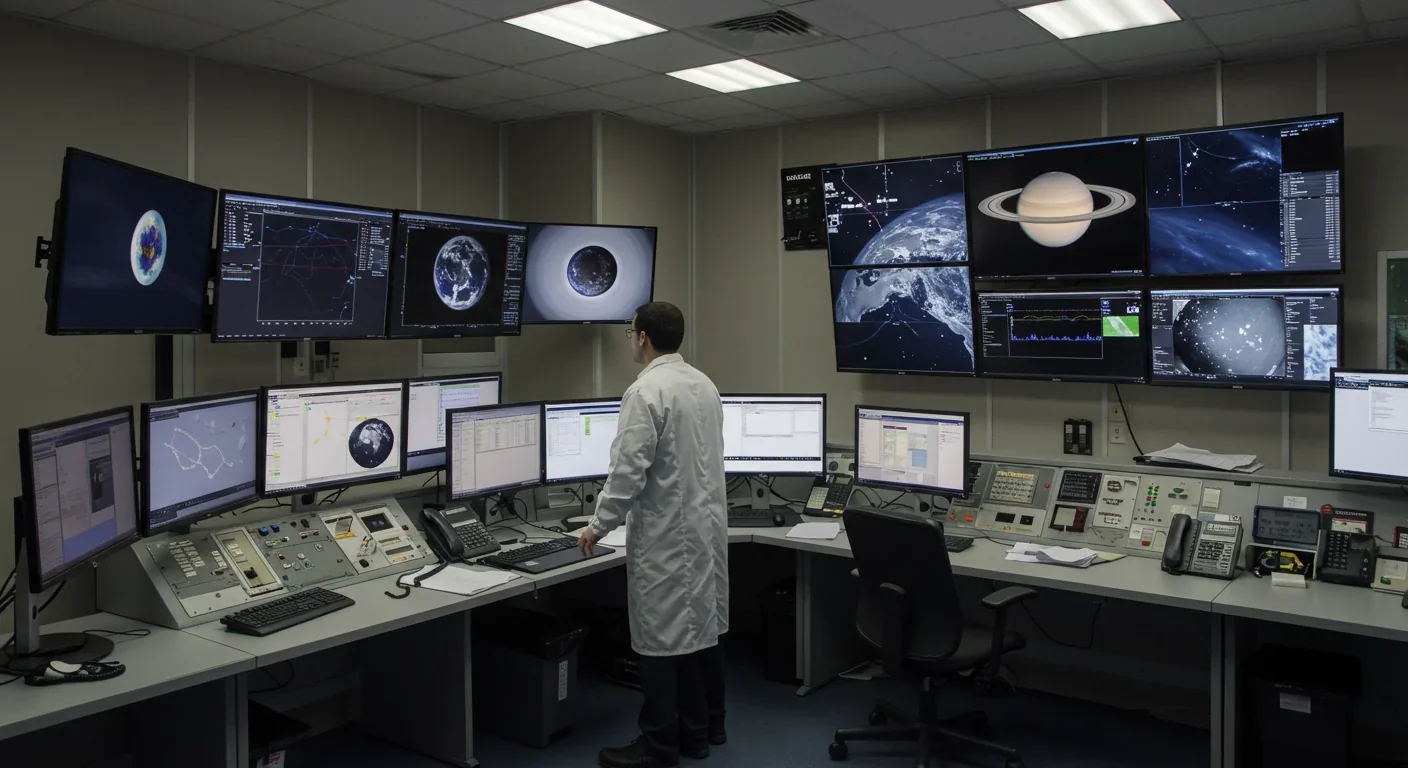Why Wormholes Collapse Instantly: The Physics Roadblock

TL;DR: Saturn's iconic rings are a temporary cosmic phenomenon, likely formed 10-400 million years ago when a moon was destroyed near the planet. These razor-thin discs of 99.8% water ice are maintained by shepherd moons and gravitational resonances, but are slowly disappearing as thousands of kilograms rain into Saturn every second. Unlike the faint, dusty rings of Jupiter, Uranus, and Neptune, Saturn's massive icy rings are visible from Earth—but NASA's Cassini mission revealed they'll vanish completely in about 292 million years. We're witnessing a rare, fleeting spectacle that won't last forever.

In about 292 million years, the most iconic structure in our Solar System will disappear entirely, raining down onto the planet it once adorned. What's happening to Saturn's rings is forcing us to rethink everything we thought we knew about planetary formation, and the clock is ticking.
For centuries, Saturn's rings seemed eternal—a cosmic decoration that had always been there and always would be. Then NASA's Cassini spacecraft plunged through the gap between Saturn and its innermost ring in 2017, and the data it sent back in its final moments shocked planetary scientists worldwide.
Cassini revealed that between 432 and 2,870 kilograms of ring material falls into Saturn's atmosphere every single second. James O'Donoghue at NASA's Goddard Space Flight Center put it in perspective: "We estimate that this 'ring rain' drains an amount of water products that could fill an Olympic-sized swimming pool from Saturn's rings in half an hour."
But the real revelation was about age. The rings aren't ancient relics from the Solar System's birth 4.6 billion years ago. They're cosmically young—likely between 10 and 400 million years old. To put that in context, if Saturn formed on January 1st, its rings didn't appear until sometime in late December. They're younger than the dinosaurs.
This discovery fundamentally changes our understanding of how planetary systems evolve. Saturn's rings aren't a permanent feature written into the planet's DNA. They're a temporary phenomenon, a fleeting cosmic accident that we're incredibly fortunate to witness.
Imagine a moon roughly the size of Mimas—about 400 kilometers across—orbiting peacefully around Saturn several hundred million years ago. Then disaster strikes. Either a massive comet slams into it at cosmic velocities, or the moon's orbit decays until it crosses a invisible threshold called the Roche limit, located 147,000 kilometers from Saturn's center (2.44 Saturn radii). At this point, Saturn's gravity becomes stronger than the moon's own gravity holding it together.
The moon doesn't explode. Instead, it slowly tears apart, like pulling cotton candy. Chunks break off, collide with each other, shatter into smaller pieces. Within a few thousand years, what was once a solid body becomes billions of fragments ranging from microscopic dust grains to house-sized boulders, all orbiting in the same plane where the original moon circled.
This is the leading theory for how Saturn got its rings, supported by three key pieces of evidence. First, the rings' low mass—about 1.5 × 10¹⁹ kilograms, roughly half the mass of Mimas—suggests they came from a relatively small parent body. Second, their extreme purity (99.8% water ice) matches what we'd expect from a moon formed in Saturn's neighborhood, where volatiles like water were abundant. Third, the sharp outer edge of the ring system and the current orbits of tiny moons like Atlas suggest the rings formed relatively recently in geological terms.
Alternative theories propose the rings might be remnants of material left over from Saturn's formation that never coalesced into moons, kept separate by tidal forces. But the rings' youth argues against this scenario—primordial material would have been contaminated by billions of years of micrometeorite impacts, yet Saturn's rings remain remarkably pristine.
A third possibility gaining traction: two of Saturn's moons collided, pulverizing each other into the icy debris we see today. Computer simulations show that such catastrophic impacts between moons are not just possible but probable over billions of years in a crowded satellite system like Saturn's.
Saturn's rings span an astonishing 270,000 kilometers from edge to edge—three-quarters of the distance from Earth to our Moon. Yet they're impossibly thin: in most places just 20 to 100 meters thick, about the height of a 30-story building. If you scaled the rings down to the size of a DVD, they'd be 10,000 times thinner than an actual disc.
This extreme flatness is no accident. It's the result of countless collisions between ring particles. Every time two ice chunks bump into each other—which happens constantly at orbital speeds up to 48,000 miles per hour—they exchange momentum. Particles with orbital inclinations (those moving "up" or "down" relative to the ring plane) collide with those in more circular orbits. Over time, these gentle collisions damp out vertical motions, forcing everything into a razor-thin disc aligned with Saturn's equator.
Why the equator? Two reasons. First, Saturn rotates rapidly (once every 10 hours and 33 minutes), creating an equatorial bulge. This bulge generates a gravitational gradient that pulls ring particles toward the equatorial plane like a restoring force. Second, Saturn's axis of rotation defines a natural symmetry plane. Any material orbiting Saturn will naturally settle into this plane due to the planet's oblate (flattened) shape.

The rings aren't uniform. They're divided into distinct regions separated by gaps, giving them a structure like a cosmic record. Moving outward from Saturn, the main divisions are:
The D Ring (innermost, starting at 66,900 km): Extremely faint and dusty, barely visible even in Cassini images.
The C Ring: Sometimes called the "Crepe Ring" because of its translucent appearance. Contains fine particles and several narrow gaps.
The B Ring: The brightest, densest, and most massive ring, containing most of the ring system's total mass. Completely opaque in most places.
The Cassini Division: A 4,800-kilometer-wide gap between the B and A rings, visible from Earth through backyard telescopes. Not actually empty—it contains sparse ringlets.
The A Ring: The outermost of the main rings, separated from the B Ring by the Cassini Division. Contains the Encke Gap (cleared by the moon Pan) and the Keeler Gap (cleared by Daphnis).
The F Ring: A narrow, kinked ring just outside the A Ring, actively shepherded by two moons, Prometheus and Pandora.
The G Ring: Faint and dusty, with an optical depth of just 0.000001, located about 2.8 Saturn radii from the planet.
The E Ring: The largest and most diffuse ring, extending from 180,000 to 480,000 kilometers from Saturn. Fed directly by geysers erupting from the moon Enceladus.
The Phoebe Ring: Discovered in 2009, this enormous dust ring extends millions of kilometers from Saturn, tilted 27 degrees from the main ring plane. Material from this distant halo slowly spirals inward, raining down onto the moon Iapetus and creating its distinctive two-toned appearance.
Saturn's rings would have long ago spread out and dissipated if not for the gravitational influence of its 62 known moons. These satellites act like cosmic shepherds, their gravity creating gaps, maintaining sharp edges, and generating intricate wave patterns throughout the ring system.
The mechanism is subtle but powerful. Consider Pan, a 28-kilometer-wide moon embedded in the Encke Gap within the A Ring. As Pan orbits, its gravity pulls on nearby ring particles. Those orbiting slightly inside Pan's orbit are pulled forward, speeding them up and pushing them into higher orbits—away from Pan. Particles orbiting just outside Pan are pulled backward, slowing them down and dropping them into lower orbits—also away from Pan. The result: Pan clears a gap around its entire orbital path like a plow clearing snow.
Cassini captured stunning video of this process in action around the F Ring, where two shepherd moons—Prometheus (inner) and Pandora (outer)—create wavelike disturbances in the ring material. Prometheus steals angular momentum from the ring, pushing itself inward and the ring outward. Pandora does the opposite, receiving angular momentum and pushing the ring inward while moving itself outward. Together, they confine the F Ring to a narrow band, preventing it from spreading.
Some moons have even more exotic relationships with the rings. Janus and Epimetheus are co-orbital satellites—they share nearly the same orbit and swap positions every few years. When the inner moon catches up to the outer one, they exchange angular momentum through gravitational interaction. The inner moon gains energy and moves to a higher orbit, while the outer moon loses energy and drops to a lower orbit. This cosmic dance affects nearby ring particles, subtly shifting ring edges and creating time-variable structures.
Daphnis, an 8-kilometer moonlet in the Keeler Gap, creates some of the most beautiful features in the rings. Its gravity raises vertical waves along the gap edges—literally pulling ring material up and down like ocean waves. These "propeller" structures, visible in high-resolution Cassini images, proved that ring particles and small moons exist on a continuum. Cassini discovered thousands of these propeller moonlets in the A Ring alone, each between 40 and 500 meters across, each creating its own miniature disturbance.
Gravitational resonances add another layer of complexity. A resonance occurs when a moon's orbital period relates to a ring particle's period by a simple ratio—2:1, 3:2, 5:3, and so on. At these special locations, the moon's repeated gravitational tugs add up coherently, like pushing a child on a swing at just the right moment. The result: particles either get kicked out, creating gaps, or get trapped, creating dense ringlets.
The Cassini Division itself is primarily caused by a 2:1 resonance with the moon Mimas. Ring particles orbiting in this region complete exactly two orbits for every one orbit of Mimas. The repeated gravitational nudges from Mimas have cleared out most material, though some particles remain trapped in stable configurations.
Why do Saturn's rings orbit the equator rather than at a tilt, like some asteroid orbits or comet paths? The answer involves three interconnected principles: the Roche limit, conservation of angular momentum, and Saturn's equatorial bulge.
The Roche limit defines the closest distance a fluid or loosely bound object can orbit a planet before tidal forces tear it apart. For icy bodies orbiting Saturn, this limit sits at about 147,000 kilometers (2.44 Saturn radii). Inside this boundary, Saturn's gravity varies so much from one side of an object to the other that the differential pull overcomes the object's self-gravity.
All of Saturn's main rings lie within this limit. This isn't coincidence—it's why they're rings rather than moons. Any large object forming here would be torn apart by tidal forces before it could become a stable satellite.
But the Roche limit alone doesn't explain the equatorial alignment. That requires understanding Saturn's shape. Saturn rotates once every 10.5 hours—so fast that centrifugal force creates a pronounced equatorial bulge. The planet is 10% wider at its equator than from pole to pole. This oblateness creates a gravitational field that's not perfectly spherical.
Ring particles orbiting at any inclination to the equator feel this asymmetric gravitational pull. The equatorial bulge's gravity pulls particles toward the equatorial plane like a restoring force. Combined with collisions that damp out vertical velocities, this torque causes orbital planes to precess (wobble) and eventually align with Saturn's equator.
Think of it like spinning a coin on a table. Initially, the coin spins at an angle, but friction and gravity cause its axis to precess until it lies flat. Saturn's rings undergo a similar process on a cosmic scale, settling into the lowest-energy configuration: a thin disc aligned with the planet's rotation.
Angular momentum conservation provides the final piece. When the original parent body broke apart, it was already orbiting in or near Saturn's equatorial plane (most moons do). The total angular momentum of the system—the product of mass, velocity, and orbital radius—is conserved. As fragments spread out and collide, they exchange momentum but can't change the system's total angular momentum vector, which points perpendicular to Saturn's equator. This locked-in directionality ensures the rings remain equatorial.
Cassini even used ring waves as a natural seismograph to probe Saturn's interior. By measuring subtle disturbances in ring particle orbits caused by oscillations in Saturn's gravitational field, scientists determined the planet's precise rotation period (10 hours, 33 minutes, 38 seconds) and gained insights into its internal structure—a remarkable example of ring particles serving as sensors for planetary physics.
Saturn isn't the only planet with rings—Jupiter, Uranus, and Neptune all have them. Yet Saturn's rings are so much more spectacular that they're the only ones visible from Earth with small telescopes. Why?
The answer lies in composition, mass, and source mechanisms.
Jupiter's rings, discovered by Voyager 1 in 1979, are thin, dark, and dusty—composed primarily of particles ejected from its small inner moons when struck by micrometeorites. Unlike Saturn's icy rings, Jupiter's are made of rocky dust with low reflectivity (albedo). They're also temporary on short timescales: dust particles spiral into Jupiter's atmosphere within decades due to electromagnetic forces. Jupiter's rings persist only because they're continuously replenished by meteoroid impacts on moons like Metis, Adrastea, Amalthea, and Thebe.
Uranus's rings, discovered in 1977 during a stellar occultation, are narrow, dark, and composed of radiation-darkened organic material and dust. The nine main rings are each just a few kilometers wide, separated by large gaps. They're shepherded by small moons like Cordelia (inner shepherd of the ε ring) and Ophelia (outer shepherd). But with a total mass estimated at only about 1/1000th of Saturn's rings, and composed of dark material rather than reflective ice, they're far less visible.
Neptune's rings, discovered by Voyager 2 in 1989, are even fainter—consisting of fine dust with occasional bright arcs. The Adams ring contains five concentrated arc segments (named Courage, Liberté, Egalité 1, Egalité 2, and Fraternité) likely resulting from a recent moon breakup within the past few thousand years. The shepherd moon Galatea helps confine these arcs through gravitational resonances, but the system is so tenuous that the arcs may disperse within decades to centuries.
Saturn's rings dominate for three reasons:
1. Composition: Saturn's rings are 99.8% water ice, which reflects up to 90% of incident sunlight. This gives them a brilliant white appearance and makes them visible from nearly a billion kilometers away. Jupiter's dusty rings, by contrast, reflect less than 10% of light.
2. Mass and extent: With a total mass of ~1.5 × 10¹⁹ kg spread over 270,000 kilometers, Saturn's rings are both more massive and more extensive than those of any other planet. Jupiter's rings are barely wider than the planet itself. Uranus's rings are narrow bands. Neptune's are barely there.
3. Longevity: Saturn's rings, though young, are still 10-400 million years old—far more stable than the transient dust systems around the other gas giants. The ring rain phenomenon means they're disappearing, but slowly. Jupiter's rings would vanish in just decades without continuous replenishment.
One intriguing question: why does Saturn have such massive icy rings when Jupiter, over three times more massive, has only dusty wisps? The answer likely relates to moon populations and recent catastrophic events. Saturn has more medium-sized icy moons orbiting near the Roche limit than Jupiter does. If one was destroyed 100-400 million years ago—whether by collision, tidal disruption, or comet impact—it would have created exactly what we see: a massive, pristine, icy ring system.
Jupiter may never have had such an event, or it happened so long ago that the rings have long since dissipated. Saturn's rings may be a lucky accident—a chance destruction captured at just the right time in cosmic history for humans to witness.
Launched in 1997 and arriving at Saturn in 2004, the Cassini-Huygens mission transformed our understanding of the ringed planet. For thirteen years, this 2,125-kilogram spacecraft orbited Saturn, flying closer to the rings than any probe before or since.
Some of Cassini's key ring discoveries:
Ring rain confirmed: By flying through Saturn's upper atmosphere during its Grand Finale phase in 2017, Cassini directly measured charged ice particles streaming down from the rings along magnetic field lines toward the planet's poles. The mass loss rate—up to 2,870 kg per second—far exceeded predictions and established that the rings are disappearing on timescales of 100-300 million years.
Ring age determined: By measuring the mass and purity of the rings, Cassini provided strong evidence that they're cosmically young—formed well after the Solar System's birth. The lack of contamination from meteoroid impacts suggests an age of 10-400 million years, not billions.
Moonlet populations revealed: Cassini discovered thousands of propeller moonlets in the A Ring, each creating characteristic disturbances in the ring material. These objects blur the line between ring particles and moons, showing that the size distribution is continuous from dust grains to kilometer-sized bodies.
Shepherd dynamics filmed: For the first time, Cassini captured video of shepherd moons interacting with rings in real time. The wavelike bands drawn out from the F Ring by Prometheus provided visual confirmation of angular momentum transfer theories.
New rings and gaps found: Cassini discovered two new faint rings and numerous new gaps associated with small embedded moons.
Ring composition mapped: Spectrographic analysis confirmed the rings are 99.8% water ice but also revealed regional variations in contamination and particle size distribution.
Vertical structures observed: Cassini imaged towering vertical structures in the rings, some reaching 3 kilometers above the ring plane—far taller than the ring thickness. These are created when moonlets disturb the surrounding material.
Seasonal changes tracked: Cassini observed Saturn through half a Saturnian year (about 15 Earth years), watching how the rings' appearance changed as Saturn's axial tilt carried them from edge-on to maximum opening relative to the Sun.
Electromagnetic interactions measured: Cassini discovered that Saturn's magnetic field interacts with charged ring particles, accelerating them along field lines toward the planet. This electromagnetic coupling provides an additional mechanism for ring material loss beyond purely gravitational effects.
Spoke patterns explained: Dark radial features called "spokes" appear seasonally in the B Ring. Cassini showed these are caused by fine dust levitated above the ring plane by electrostatic forces when Saturn's magnetosphere and solar illumination create charging conditions.
The mission ended on September 15, 2017, when Cassini was deliberately plunged into Saturn's atmosphere to avoid any possibility of contaminating potentially habitable moons like Enceladus. As it burned up, it transmitted data until the final second—a fitting end for a spacecraft that had revolutionized our understanding of the most beautiful planet in our Solar System.

Given that ring particles constantly collide and that gravity pulls everything toward Saturn, why haven't the rings either clumped into moons or spiraled into the planet long ago?
The answer is a delicate balance of competing forces:
Orbital velocity prevents infall: Ring particles orbit at speeds of 20-30 km/s, fast enough that centrifugal force balances Saturn's gravity. Like the International Space Station orbiting Earth, they're in continuous free fall but moving sideways fast enough to keep missing the planet.
The Roche limit prevents aggregation: Inside the Roche limit, tidal forces are stronger than self-gravity. If particles tried to clump together into a moon, Saturn's differential gravity would pull them apart. This is why ring material remains fragmented.
Collisions damp vertical motion but preserve orbits: When particles collide, the impacts are nearly elastic (bouncy) because they're ice striking ice at similar velocities. These collisions transfer vertical momentum, flattening the disc, but don't significantly change orbital energy. It's like bumper cars on a circular track—collisions slow and redirect the cars but don't make them spiral inward.
Shepherd moons prevent spreading: Without confinement, ring particles would gradually spread both inward and outward due to collisions and small perturbations. Shepherd moons provide the necessary gravitational walls, keeping particles confined.
Replenishment balances loss: While ring rain drains material from the inner rings, other processes add material. The E Ring, for example, is continuously replenished by ice particles from Enceladus's geysers. Micrometeorite impacts on larger ring particles create dust that temporarily replaces what's lost. This isn't enough to maintain the rings forever, but it slows their decay.
Yet this equilibrium is temporary. Multiple loss mechanisms are slowly destroying the rings:
Ring rain: Charged particles spiral along magnetic field lines into Saturn's atmosphere. This is the dominant loss mechanism.
Meteoroid bombardment: Impacts vaporize ring material or knock particles into new orbits where they're swept up by moons or fall into Saturn.
UV radiation: Sunlight breaks molecular bonds in the ice, creating gases that escape the ring system.
Plasma drag: Interactions with Saturn's magnetosphere exert drag on charged particles, causing orbital decay.
Combined, these processes give Saturn's rings an expiration date. Most projections suggest the inner rings (B, C, D) will disappear within 100 million years. The A and F rings might last another 200 million years. Eventually, Saturn will look as barren as Jupiter—a cautionary reminder that even the most magnificent cosmic structures are temporary.
Saturn's rings have captivated humanity since Galileo first glimpsed them in 1610 through his primitive telescope. Not understanding what he was seeing, he described Saturn as having "ears" or "handles." When he looked again two years later and found them gone (due to Earth passing through the ring plane), he was baffled.
Christiaan Huygens, in 1655, first correctly identified them as a disc "surrounding the planet, nowhere touching, and inclined to the ecliptic." Since then, the rings have inspired countless works of art, music, and literature, becoming the iconic symbol of planetary science.
Different cultures have brought unique perspectives to ring studies:
Western astronomy has focused primarily on physical mechanisms—orbital dynamics, tidal forces, resonance theory. The mathematical tradition from Newton through Laplace to modern computational modeling has produced our current detailed understanding.
Soviet/Russian planetary science made crucial contributions through the Venera and early Voyager era, particularly in understanding electromagnetic interactions between rings and magnetospheres.
Japanese researchers have pioneered detailed particle simulation codes that model individual ring particle interactions, revealing emergent structures from simple collision rules—an approach influenced by Japanese traditions in emergent phenomena and complex systems.
Indian astronomers have contributed significant work on the optical properties of rings and how their appearance changes with viewing geometry, informed by centuries of observational astronomy tradition.
The rings also raise profound philosophical questions. Are we living in a special time—the brief cosmic moment when Saturn has rings? If these rings formed only 100-400 million years ago and will disappear in another 100-300 million years, that's a window of perhaps 500 million years out of the Solar System's 10-billion-year total lifetime. We're witnessing a rare, beautiful, temporary phenomenon.
This perspective appears in discussions of anthropic reasoning and observation selection effects. We can only observe the universe during epochs and locations where observers can exist. Complex life took billions of years to evolve on Earth. By the time we achieved civilization capable of building telescopes, Saturn happened to have rings. Pure luck? Or is there some deeper principle linking the timing of technological civilization to rare cosmic phenomena?
Most scientists favor luck. Planetary rings appear and disappear throughout cosmic history. We happen to live during a period when Saturn has spectacular ones. In another 400 million years, intelligent beings (if any exist) will see a ringless Saturn and might discover evidence of ancient rings only through subtle clues—perhaps unusual dust in Saturn's atmosphere, or anomalies in moon orbits.
Earth passes through Saturn's ring plane every 13-15 years, when the rings appear edge-on from our perspective. During these events, the rings effectively vanish—their 10-meter thickness is too small to see across interplanetary distances. The most recent ring plane crossing was in March 2025.
But there's a permanent disappearance coming. At current loss rates, the rings will fade over the next 100-300 million years. The sequence of disappearance will be:
Phase 1 (100 million years): The inner D, C, and innermost B rings fall into Saturn. The Cassini Division widens as the B Ring shrinks from the inside out.
Phase 2 (200 million years): The B Ring, despite being the most massive, continues to drain. The A Ring thins noticeably. The F Ring, already tenuous, becomes barely detectable.
Phase 3 (292 million years): Only faint traces of the outer A Ring and possibly the E Ring (still fed by Enceladus) remain. Saturn resembles Uranus—technically possessing rings, but nothing like its former glory.
Phase 4 (300+ million years): Without continuous replenishment, even the E Ring eventually dissipates as Enceladus's geological activity wanes. Saturn becomes essentially ringless.
Could new rings form after these disappear? Possibly. If another moon is destroyed by collision or tidal disruption, a new ring system could appear. But the odds of this happening during humanity's existence are vanishingly small.
One wild card: a comet or asteroid impact. If a large object struck Saturn's upper atmosphere at high speed, or collided with one of the inner moons, it could accelerate ring loss or even create new temporary structures. Such events are unpredictable but inevitable given enough time.
For now, we're privileged witnesses to one of nature's most magnificent temporary artworks. Every image of Saturn captures a planet in a state that won't last—a cosmic Snapchat that will eventually vanish.
Saturn's rings are more than beautiful—they're a natural laboratory for studying processes that shaped the Solar System.
Accretion in action: Ring particles constantly collide, stick together briefly, then break apart—the same process that built planets from the protoplanetary disc 4.6 billion years ago. By studying how ring particles aggregate and fragment, we learn about planet formation under controlled conditions.
Tidal disruption dynamics: The rings demonstrate what happens when a moon ventures too close to a planet. This process likely occurred countless times in the early Solar System, shaping moon populations around all giant planets.
Resonance sculpting: The gaps and divisions carved by moon resonances in Saturn's rings show how Jupiter's resonances created gaps in the asteroid belt and how Neptune's resonances sculpt the Kuiper Belt. The same physics operates across vastly different scales.
Electromagnetic interactions: The ring rain phenomenon, driven by charging and magnetic field interactions, reveals processes relevant to dusty plasma environments throughout the universe—from protoplanetary discs to debris discs around other stars.
Temporary structures: The youth and impermanence of Saturn's rings challenge our intuition about cosmic timescales. They remind us that planetary systems are dynamic, evolving, and full of surprises. What we observe today is a snapshot, not an eternal state.
Observations of debris discs around other stars—dusty rings of material orbiting young and mature stars—may be detecting Saturn-like ring systems. If so, rings might be common but transient throughout the galaxy. We're not seeing something unique to Saturn, but rather catching Saturn during a universal but brief phase that all giant planets occasionally experience.
Cassini's mission ended in 2017, and no follow-up Saturn mission is currently funded or in development. But proposals exist:
Dragonfly: This quadcopter mission, scheduled to launch in 2027 and arrive at Saturn's moon Titan in 2034, won't focus on the rings but will provide new perspectives during flybys.
Proposed ring-focused missions: Concepts include an orbiter dedicated to studying ring dynamics in unprecedented detail, possibly with ring-grazing trajectories that sample particles directly. Another idea: landers on small moons like Pan or Atlas that could study ring material up close.
Groundbased observations: As Saturn's rings open to their maximum tilt (about 27 degrees) in the early 2030s, ground-based telescopes including the James Webb Space Telescope will capture them at their most spectacular. Detailed spectroscopy could reveal subtle compositional variations Cassini missed.
Key unanswered questions include:
What is the exact age of the rings? Current estimates range from 10-400 million years—a factor of 40 uncertainty.
Did the rings form from one catastrophic event or multiple smaller ones?
How do propeller moonlets form and how long do they last?
What exactly causes the spoke patterns, and why do they vary seasonally?
How does the ring rain phenomenon couple with Saturn's auroras and magnetosphere?
Are ring systems common around extrasolar giant planets, and if so, how can we detect them?
Could rings have existed around rocky planets like Earth in the distant past?
One particularly tantalizing question: could a gas giant develop rings in its habitable zone, and might those rings help sustain life? Imagine a moon orbiting a ringed planet at just the right distance for liquid water. Twice each orbit, it would pass through the ring shadow, creating seasonal light variations unlike anything on Earth. The ring particles, raining down onto the planet and its moons, could deliver water and organic materials. It's speculative, but Saturn's rings remind us that planetary systems can be far stranger and more beautiful than we imagine.
We live in a golden age for Saturn's rings. They're young, spectacular, and accessible to our telescopes and spacecraft. But the cosmic clock is ticking. Every second, thousands of kilograms of ancient ice fall from the rings into Saturn's clouds, never to return. Every year, the rings grow imperceptibly thinner. Every million years, another noticeable fraction disappears.
In 100 million years, when the first fragments vanish entirely, humanity will either be long extinct, or we'll have evolved into something unrecognizable, or we'll have spread across the Solar System and galaxy. If our descendants exist, they'll look back at our time as the era when Saturn still had its rings—when you could point a backyard telescope at that yellowish dot and see something no human in the far future will ever witness firsthand.
Saturn's rings teach us that beauty is temporary, that even cosmic structures have lifespans, and that we're profoundly fortunate to live in this particular moment. They remind us that the universe is not static but constantly changing, and that every observation we make captures a fleeting configuration that will never repeat.
The next time you see Saturn—whether through a telescope, in a photograph, or as a bright "star" in the night sky—pause for a moment. You're looking at something genuinely special: a cosmic artwork billions of years in the making, but destined to fade. Appreciate it while it lasts. The rings won't wait forever.

Wormholes collapse instantly because they require exotic matter with negative energy that doesn't exist in useful quantities, and quantum instabilities destroy them faster than light can cross their throats, making spacetime shortcuts a physics impossibility.

Scientific studies reveal electromagnetic hypersensitivity sufferers experience genuine symptoms but cannot detect EMF exposure better than chance, pointing to the nocebo effect rather than electromagnetic fields as the primary cause.

Mycelium packaging grows from agricultural waste in days, decomposes in weeks, and is already shipping in Dell computers and IKEA furniture—proving fungi can replace foam.

Our attraction to impractical partners stems from evolutionary signals, attachment patterns formed in childhood, and modern status pressures. Understanding these forces helps us make conscious choices aligned with long-term happiness rather than hardwired instincts.

Virtual reality experiments are revealing how honeybees form sophisticated cognitive maps with brains smaller than sesame seeds, revolutionizing our understanding of intelligence and inspiring energy-efficient robots while guiding pollinator conservation.

Millions of student loan borrowers are refusing to repay as an organized protest against a $1.77 trillion debt system they view as exploitative. With one in three borrowers at risk of default by 2025, this movement challenges whether the entire higher education financing model can survive.

Blockchain-based social networks like Bluesky, Mastodon, and Lens Protocol are growing rapidly, offering user data ownership and censorship resistance. While they won't immediately replace Facebook or Twitter, their 51% annual growth rate and new economic models could force Big Tech to fundamentally change how social media works.